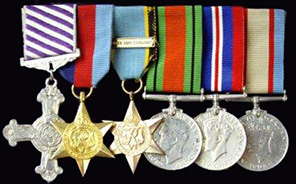
From left to right: Distinguished Flying Cross, 1939–1945 Star, Air Crew Europe Star (with France and Germany Bar), Defence Medal, War Medal, Australia Service Medal
Warrant Officer Lawrence William Woods (No. AUS 408463)

Profile of Laurie Woods to prove medal entitlement
Letter to Canberra regarding Medal Entitlement
For service during World War II Australian personnel were awarded Imperial campaign medals. Other medals were also awarded to recognise gallantry and distinguished service.
Imperial campaign medals:
Medals for gallantry and distinguished service:
Other medals/awards:
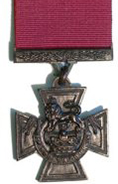
The highest decoration that can be awarded in the United Kingdom to all members of the three services is the Victoria Cross instituted by Queen Victoria in 1854. In World War Two 13 members of Bomber Command were awarded the Victoria Cross or VC for short, at least this number again were recommended but not awarded this highest of decorations and one that has the greatest respect and admiration the world over. It was also the only decoration that could and still can be awarded posthumously.
The more famous awards of the VC to Bomber Command was Sgt. Middleton (posthumously), Wing Commander Hughie Edwards for leading the low level attack on Bremen in 1942, to Wing Commander Guy Gibson for leading 617 Squadron's attack on the Ruhr Dams in Germany, and to Group Captain Leonard Cheshire for extended meritorious service.
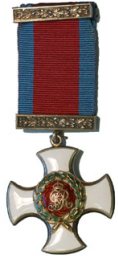
The next highest award that all members of the three services including Bomber Command was the Distinguished Service Order, or DSO for short. Many DSO's were awarded to squadron commanders for a long period of leadership but in some cases it was awarded to junior officers for one operation.

The Distinguished Flying Cross or DFC was in the main awarded to officers of the Royal Air Force, and many members of Bomber Command were awarded this decoration with its distinctive diagonal blue stripe, one of three flying awards having this distinct style of ribbon. The DFC could be awarded for a tour of operations, or an immediate award for one operation. Made from silver the medal did not carry the recipients number, rank and name but was only dated with the year that it was awarded.
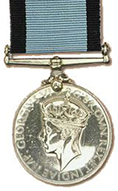
This medal was first awarded after the Crimea War. It was originally awarded to the Royal Navy only, and in January 1943 it was instituted as a direct equivalent to the DSO (Distinguished Service Order), but was awarded to NCO's (Non–Commissioned Officers). (Flying) was added to the title. Only 112 of these medals have been awarded, 80 of which were awarded to Bomber Command.
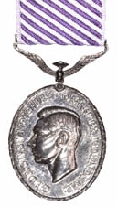
The Distinguished Flying Medal or DFM, was the equivalent award to non–commissioned officers and other ranks of the DFC. And could be awarded for a tour of operations or an immediate award for one operation. Made from silver the medal had the recipients number, rank and name on the edge.
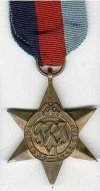
Awarded for 60 days operational service for air crew personnel between 3 September 1939 to 2 September 1945, the 1939–45 Star is a six pointed gold star suspended from a dark blue, red and pale blue equal striped ribbon [said to represent the Royal Navy, Army and Royal Air Force]. 'The 1939–45 Star' is inscribed and the medal was in some circumstances issued in lieu of injury, death or capture. In some instances the Battle of Britain clasp was awarded.
Originally you had to complete an operational sortie in the European Theatre of Operations with definite risk of enemy action to qualify; this counted even though you were with an operational training unit or at a general reconnaissance school. This was amended to include any aircraft operations, even within the UK, meaning that many air crew were able to also qualify for the Air Crew Europe Star with France and Germany clasp, rather than just the France and Germany Star.
See the letters regarding the Air Crew Europe Star eligibility for more information.
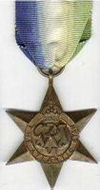
Award for six months service between September 1939 and May 1945, in the areas Atlantic, home waters, Russian Convoy and South Atlantic. Personnel must have already obtained the 1939–45 star. Merchant Navy personnel, Royal Air Force and Army also qualified.
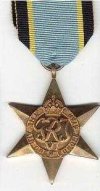
The only campaign star awarded solely to the Royal Air Force was the Air Crew Europe Star, commonly referred to as the Survival Star, if you lived to receive it. The requirement for this medal along with the Atlantic Star was quite arduous and complicated.
The first two months on a squadron qualified you to the 1939-45 Campaign Star, the next two months completed qualified you for the Air Crew Europe, provided one operational sortie had been completed. This star was introduced on the 3rd September 1939 and ceased on the 5th June 1944.
Those who having qualified for the Air Crew Europe and flew after the 5th June received a clasp or bar France and Germany to wear on the Air Crew Europe Star.
Those that went over the 5th of June but had not completed 2 months or 60 days received the France and Germany Star.
It means in this instance that having started flying on operation say in February 1944 one must complete the required 60 days before the 5th but if you went over this date by only a matter days you did not receive the coveted Air Crew Europe Star. This means in essence that you had flown something like 58 days of the required 60 but did not get the medal because you had flown after the 5th of June.
If a man was killed he would be awarded the star irrespective of the time he had served. If a man was wounded or injured and could not continue his service towards the 60 days he would be awarded the star irrespective of time served. Time as a prisoner of war counted provided the first two months and the 1939 star had been awarded. But if you evaded capture and got back to the UK before completing the required two months or 60 days you were not awarded the star. The service could not be continued until the required 60 days had been reached as evaders were not allowed to fly over enemy or enemy occupied territory, particularly having been helped by the escape organisations in Europe.
Because of the subsequent amendment to the conditions for qualifying for the 1939-45 Star, many air crew became eligble for the Air Crew Europe Star with France and Germany clasp. See the letters regarding the Air Crew Europe Star eligibility for more information.
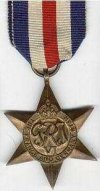
The France & Germany Star was awarded to all three services after June 5th 1944. The men of Bomber Command were awarded this star for flying operations over Europe.

Awarded for service in the Pacific theatre between 8 December 1941 and 2 September 1945 as follows:
A person qualifying for both the Pacific Star and the Burma Star is awarded only the first Star earned. A Clasp is worn denoting service for the other Star.

The Defence medal was also awarded to all three services plus the civilian services such as the civil defence, police, fire service, Home Guard, were also eligible provided the qualifications for the medal were complied with.
For members of Bomber Command they had to have three years non–operational service, if they had been in any of the above civil services prior joining the RAF this service could contribute towards the required three years. In some cases men would come into the services already having qualified for the Defence Medal. Overseas services of a over a year qualified for the medal.
Many would say that everybody who served in country in any capacity should qualify particularly with it being called the Defence Medal but this was not so. One classic example of a man who did not qualify for the Defence Medal was the late Wing Commander Guy Gibson VC, DSO & Bar, DFC & Bar. He led 617 Squadron on the famous Dambuster for which he was awarded the VC. His service from September 1939 to September 1944 when sadly he was killed on an operation did not include three years non–operational service. Those that were killed through war service and those awarded a decoration were awarded the Defence Medal irrespective of the length of service.
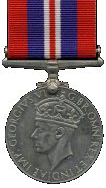
The War Medal (3 September 1939– 2 September 1945) was awarded to all full–time personnel of the Armed Forces no matter where they served. The only qualification for award of this medal was that they must have served at least 28 days irrespective of whether they were operational or non operational.
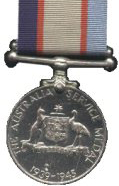
This Medal can claim to be the first truly distinctive Australian medal. The Medal was created by King George VI in 1949 and counter signed by Prime Minister Ben Chifley to recognise World War II service by members of Australia's armed forces and the Volunteer Defence Corps.
This Medal was in addition to a range of British medals and campaign stars that could be earned by Australians for service in World War II. The qualifying service criteria for the Medal – 18 months for full–time service or 3 years for part–time service – was amended in 1996 to 30 days and 90 days respectively. Applications for this Medal can be obtained from the relevant service medals sections in the Department of Defence, Canberra.
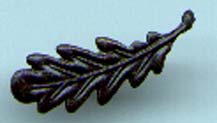
The last award also awarded to all members of the three services was a Mention in Dispatches or MID, which as with the VC could be awarded posthumously. A classic example is all 50 men, including Bomber Command who were shot after the great escape in 1944 were awarded posthumously an MID. This award was depicted by a bronze oak leaf on the War Medal.
It has long been the practice of commanders in the field to write accounts, or dispatches to their superiors, of their campaigns and to include the names of those soldiers who gave distinguished service. Originally it was nothing more than a method of bringing the names of deserving officers to the attention of higher authorities. Gradually a system of orders and decorations evolved to give a tangible reward for bravery and service. Being "mentioned in dispatches" became part of this larger honour system. The names of those "mentioned" were always published in the London Gazette.
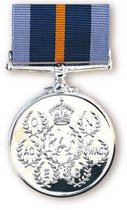
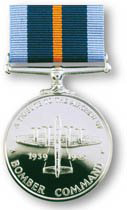
Although there was no official campaign medal awarded for members of Bomber Command an unofficial medal was struck. Sixteen years ago (now Twenty years ago) a competition was held in a magazine to design a medal for Bomber Command. The idea was to mint a small number of medals and no more.
The first medal minted was taken off the mint by Lady Jill Harris the widow of Sir Arthur Harris who before his death in 1984 gave his permission and full backing to an unofficial medal being minted. The second medal was taken off the mint by Don Bennett the wartime leader of the Pathfinder Force.
There were no thoughts of minting any further medals until the word got out and a request from ex–Bomber Command aircrew and ground crew was received to make the medal available for all those that had served in Bomber Command.
Bomber Command veterans have raised the question of entitlement to a Bomber Command medal as an official medal. Please see the Bomber Command Medal section for details on the fight to get recognition.
The committee who were responsible for medals awarded for World War II was formed in 1946 but had only two officers from the Royal Air Force. The control entitlement and issue of medals lies at PMA Sec 1C at RAF Innsworth, Gloucester. They process all applications for medals to ex–members of the RAF in World War II.
Their task is a tough one, one hand trying to be fair and correct and on the other keeping to the rules bounding the issue of medals. If you are entitled or think you are entitled to a particular medal or medals they will make sure within the rules that all medals due to you are issued. Please be patient and work with them and not against them they are firmly on your side so give them all the help and information you can. In some cases a copy from your flying log book concerning a particular operation that may not be on your service records will suffice.